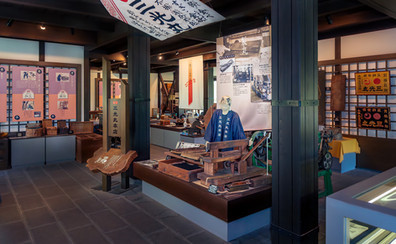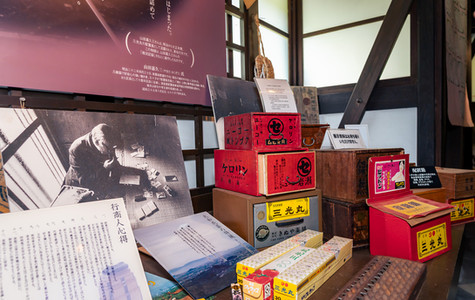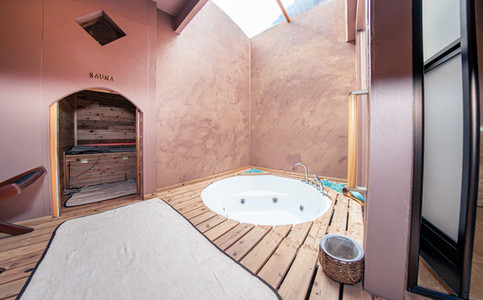Things To Do In Gose City
- NARA Visitor Center & Inn
- Sep 12
- 15 min read
Updated: Sep 13
Gose City lies in the southwestern part of the Yamato Plain and can trace its origins back to ancient Yamato Province. During the Kofun and Nara periods, it served as the stronghold of the influential Katsuragi clan, a legacy still visible in the numerous burial mounds and Shinto shrines found throughout the city. Visitors to Gose can explore historic shrines, ancient burial sites, and spiritual landmarks. The city also offers a range of experiences, from visiting a traditional soy sauce brewery and cooking with local Yamato vegetables to hiking the ascetic routes of Mount Kongo and Mount Katsuragi or e-biking along the ancient Katsuragi Kodo road.


The heart of Gose retains the character of an Edo-period merchant and temple town with some neighborhoods so well preserved that the original layouts of Edo-era cadastral maps remain accurate references today. Traditional waterways running between houses and historic buildings are carefully maintained, giving the area the atmosphere of a designated preservation district.
The townscape blends the foundations of the early modern period with the traces of Showa-era life, offering a tangible sense of continuity. Today, it is recognized as one of Japan’s best-preserved historic areas, surrounded by the natural beauty of the Katsuragi and Kongo mountains.
INDEX
Morison Fountain Pen & Cafe | Sankogan | Takakamo-jinja Shrine | Takamahiko-jinja Shrine | Hashimoto-in Temple | Katsuragi Hitokotonushi-jinja Shrine | Mount Katsuragi | Tsumugu | Kikka Gin | Kominka Katsuemon | Gosemachi Kosatsuba
Morison Fountain Pen & Cafe
Morison Fountain Pen & Cafe is located adjacent the aforementioned RITA Gosemachi Guesthouse in what was once the site of a once-prominent domestic fountain pen brand. Morison Fountain Pen, founded in 1918 by Torajiro Tanigawa, earned a reputation in the Kansai region for its modern design and fine nibs that preserved the clarity of kanji. Though the brand ceased production with the rise of ballpoint pens and changing retail trends, the spirit of craftsmanship endures in this thoughtfully reimagined space.

Today, the building serves as both cafe and bar. By day, guests can enjoy coffee and lunch surrounded by period furnishings and displays of rare Morison pens. The atmosphere is modern-retro, with careful attention to detail evident throughout. At lunch, the house specialty is a curry made with a proprietary blend of spices, notable for its depth of flavor, including a nihonshu infused curry, which incorporates sake-lees from nearby Kaze-no-Mori in its recipe. Pasta dishes are also available, and handmade chiffon cake is served during cafe hours, with monthly variations to keep the offering fresh.
In the evening, the space transforms into a bar with an ambience offering a selection of whiskies and a menu centered on skillet dishes. These range from grilled duck and German potatoes to grilled pasta and salt-seasoned fried chicken, all well-matched to drinks. The small cast-iron pans are suited to both solo diners and groups. For those seeking a more substantial meal, courses featuring locally raised Yamato duck from the foothills of Katsuragi are available by reservation, including both hot pot and Western-style preparations.
The interior retains a sense of nostalgia, with tatami seating and private rooms available for gatherings. The decor includes not only fountain pens but also period furnishings and playful touches, inviting guests to linger and explore. Morison Fountain Pen & Cafe welcomes parties and casual dinners alike, offering a setting that bridges past and present in understated fashion.
Access
Address: 1069 Nishimachi, Gose, Nara 639-2215
Tel: 0745-63-1881
Hours: 11:30 - 15:00 (L.O. 14:30) & 18:00 - 22:00
Closed: Monday & Tuesday
Sankogan Museum of Pharmacy
Nara’s reputation as the birthplace of Japanese medicine is well established. Since the founding of Yakushi-ji Temple in the 7th century, the region has quietly fostered a culture of herbal remedies and natural health. Among the most enduring of these traditions is Sankogan, a medicine whose origins stretch back over 700 years to the Kamakura period. Today, visitors can step inside this world at the Sankogan Kusuri Museum in Gose City.
The museum offers free admission and provides a rare opportunity to learn about the history and practice of “Yamato Medicine.” The exhibits trace the evolution of medicinal herbs and pharmaceutical techniques, with displays of traditional tools and ingredients. They have a fine selection of deer horns that you can touch and also a genuine narwhal tooth that is over a century old. The museum is set amid herb gardens and little walking trails, allowing guests to see, touch, and even smell the plants that have shaped local medical wisdom for centuries.
A highlight of any visit is the guided tour, available by reservation. The museum director leads guests through the collection, sharing stories that illuminate both the science and folklore behind Sankogan. While the tour is conducted in Japanese, visitors who wish to fully appreciate the explanations are advised to bring a translator. Translation apps are also a practical solution.
The museum also offers a glimpse into the adjoining factory, where Sankogan is still produced using time-honored methods. The factory is set up in such a way that the manufacturing process is set beside the windows as to be fully observed from the outside. As you walk around the perimeter, you can see into the factory and watch the process unfold first hand. Visitors can observe the careful selection of ingredients and the meticulous attention to quality that defines the brand.This openness is a point of pride for the company, which has always welcomed inspection and values customer trust.
Sankogan itself is a blend of four herbal ingredients: swertia herb, phellodendron bark, cinnamon, and licorice root. The formula is designed to support digestive health and restore balance to the body, addressing symptoms such as stomach discomfort, fatigue, and poor appetite. The medicine is sold through a network of trusted dealers, a system that emphasizes personal connection and ongoing feedback. The name “Sankogan” was bestowed by Emperor Go-Daigo, a detail that underscores the medicine’s historical significance. The company remains committed to preserving its traditions for future generations, maintaining the same manufacturing methods and dedication to quality that have defined it for centuries.
For those interested in experiencing a living example of Nara’s medicinal heritage, the Sankogan Kusuri Museum offers both education and insight. The visit is free, the setting is tranquil, and the story is one of quiet persistence and the the value of ancient wisdom in modern life.
Where to buy Sankogan
The best way to buy Sankogan is either from their online store or direlctly at the museum itself. It is also available at a few select pharmacies and drugstores specializing in traditional medicine. For any quiries, they invite you to contact them by email via their website. Inquiries by phone are accepted in Japanese only.
Access:
Address: 606 Imazumi, Gose, Nara 639-2245
Tel: 0745-67-0003
Hours: 09:00 - 16:00
Closed: Saturday, Sunday & public holidays
Fee:
Takakamo-jinja Shrine
As you leave the main road and turn onto a farm road, an old vermilion torii gate comes into view around the corner. Passing through the gate, you'll find a purification basin on your left and a large pond where colorful koi swim. A floating stage is set up on the pond, and traditional performances like gagaku are sometimes held there, depending on the season. You can also buy food at the shrine office across the pond to feed the koi. In addition to ema (wooden plaques) and amulets, the shrine sells omikuji (fortune slips) designed in the shape and color of ducks, reflecting the "Kamo" in the shrine's name, which is a nice touch and make lovely keepsakes.
Near the shrine office stands an equestrian bronze statue of Kusunoki Masashige. It is said that he frequently visited this shrine to pray for victory in battle. As you walk straight along the gravel path with the statue in view, you'll come across a stone torii directly ahead, a sacred cedar tree on the right, and the worship hall on a hill in front of you. According to the Gose City website, this shrine enshrines the guardian deity of the Kamo clan, a prominent aristocratic family of Yamato.
During the mid-Yayoi period, the Kamo clan spread from this area to various parts of the country, establishing shrines dedicated to their deity. Among these, the Kamo Shrine in Kyoto is well-known, and Takakamo-jinja Shrine is recognized as the head shrine of these Kamo shrines. The history of the founding of the nation prominently features the enshrined deity of the main shrine, and it is said that this deity accomplished the great task of nation-building, as recounted in the myth of the descent of the heavenly grandson from Takamagahara.
The main worship hall exudes a sacred and commanding presence on the hill and is certainly worth seeing. In spring, the young vibrant leaves are punctuated by the delicate pink hues of the surrounding sakura trees, in summer the deep green foliage is lush, and in autumn, the colorful leaves add a beautiful touch making Takakamo-jinja Shrine appealing throughout the year.
Access
Address: 1110 Kamogami, Gose, Nara 639-2343
Tel: 0745-66-0609
Hours: 08:00 - 17:00
Fee:
Approximately 30 minutes by car from Kintetsu Kashihara Jingu-mae Station.
By train. Take the Kintetsu Osaka Line to Takada Station then take the number 70 bus headed for Gojo Bus Center. (23 stop/37 minutes) Alight at Kazenomori bus stop then a 15 minute walk.
D
Takamahiko-jinja Shrine
Takamahiko-jinja Shrine is located about a 10-minute drive from Takakamo-jinja Shrine. The journey involves ascending a short but steep slope. The sacred object of worship is Shirakumo Peak, which stands behind the shrine and is locally known as "Shirakumo-dake." The surrounding area is called "Takama," and according to Japan's oldest historical text, the "Kojiki," it is believed to be the region of the mythological descent of the heavenly deities, known as "Takamagahara."
The elevation in this area is approximately 470 meters, and the air feels noticeably cooler than in the lowlands. The clear water flowing from Shirakumo Peak is used for the shrine's purification basin, although it is not suitable for drinking.
A path lined with ancient cedar trees, some said to be around a thousand years old, leads up to the moss-covered torii gate. Walking this path can calm one's mind before worship. Alternatively, there is a farm road alongside the approach that allows for vehicle access.
According to the city's website, this shrine enshrines Takamimusubi-no-Kami, who appears in the myths of the Kojiki and Nihon Shoki as a deity who issued orders for emissaries to transfer land to Izumo. Additionally, it enshrines Ichikishimahime-no-Mikoto and Sugawara no Michizane. The main hall is made of cedar planks and, while not ornate, offers a serene environment surrounded by mountains for expressing gratitude and prayers.
Access:
Address: 158 Kitakubo, Gose, Nara 639-2334
Tel: 0745-66-0609
Hours: Open 25hrs
Fee:
Hashimoto-in Temple
Hashimoto-in Temple, located on the slopes of Mount Kongo, is a Koyasan Shingon Buddhist temple. This place is said to be the legendary site mentioned in the "Kojiki" as the land of heavenly descent, and it has been revered as a sacred site since its establishment in 718.

Once a sub-temple belonging to Kofuku-ji. It was once a prestigious temple where the famous Tang dynasty monk Jianzhen served as chief priest. However, it suffered destruction during attacks by the Northern Court, leaving only Hashimoto-in today. On the 21st of each month, during Kobo Daishi's festival day, the principal image of the Eleven-Faced Kannon Bodhisattva housed in the Kannon Hall is displayed. Visitors can also experience creating illustrated sutras. The temple's treasure, a rare wooden statue of Nirvana from the Muromachi period, is currently housed in the Nara National Museum.
According to temple staff, many people visit just to see the delicate "Renge Shoma" flowers. These flowers bloom intermittently in shaded areas of the temple garden and are known as "forest fairies," a rare species native to Japan and popular among photographers. Beyond a narrow path at the back of the temple lies the "Garden of Meditation," another highlight. This garden, lovingly maintained by temple staff, is adorned with trees and flowers that change with the seasons. Its simplicity allows for quiet reflection amidst nature, making it a hidden gem. Spending time surrounded by abundant nature can bring a sense of tranquillity to one's heart—a feeling you might experience at this temple.
Access:
Address: 350 Takama, Gose, Nara 639-2336
Tel: 0745-66-2141
Hours: Open 24 hrs
Approximately 5 minutes by car from Takamanohiko-jinja Shrine
Katsuragi Hitokotonushi-jinja Shrine
Nestled on the eastern slopes of Mount Katsuragi, this shrine is renowned for granting wishes expressed in a single word. Its historical significance is underscored by mentions in the "Kojiki," Japan's oldest chronicle.
The shrine is dedicated to the deity Hitokotonushi, who according to legend, appeared during Emperor Yuryaku's hunt on Mount Katsuragi. Despite his unattractive appearance, which caused him to work only under the cover of night and disappear by dawn, he played a pivotal role in assisting En no Gyoja (a legendary ascetic) in building a bridge between Mount Katsuragi and Mount Kimpusen in Yoshino. The Kojiki attributes to Hitokotonushi an extraordinary ability to fulfil wishes articulated succinctly, encapsulated by the Japanese terms hitokoto or ichigon, meaning "a single word."
His unique ability to grant wishes has endeared him to many, earning the shrine the affectionate nickname "Ichigon-san." Over time, it has become a revered destination for devotees from across Japan, drawn by its mystical heritage and promise of wish fulfilment. This spiritual center holds a special place in the hearts of locals and visitors alike.
Opposite the worship hall stands a sacred ginkgo tree, over 1,200 years old, emanating an aura of divinity. To the right of the worship hall lies a corridor of red torii gates leading to an Inari Shrine and a statue of Emperor Yuryaku. Perched on elevated ground, the shrine provides sweeping views of the plains below.
Access:
Address: 432 Moriwaki, Gose, Nara 639-2318
Tel: 0745-66-0178
Hours: Open 24 hrs
Approximately 10 minutes by car from Katsuragi Hashimoto-in Temple
Here's a video roundup of the above 4 sacred sights that we visited recently during a
Other Sightseeing Spots in the Area
Mt. Yamato Katsuragi
Mount Yamato Katsuragi, standing at a height of 959 meters, is a notable peak within the Kansai region, straddling the border between Nara and Osaka Prefectures. The views at the peak are stunning and the azalea forest in particular, offers a stunning display of color in the spring, attracting numerous visitors.
There are three popular ways to get to the top of the mountain. One is by ropeway, then a 30 minute walk. The 2 main routes are hikes that you can join nearby the ropeway station. The northern Ridgeline path, known as the Diamond Trail, meanders up the mountain and is quite gentle. The Diamond Trail is a long-distance nature trail that traverses the ridgeline of the Kongo-Katsuragi Mountain Range, covering a total length of about 45 kilometers. The other is short and steep with extensive wooden steps covering and elevation gain of approximately 400 meters over a short distance is therefore not recommended for beginners. The trail can be especially dangerous and slippery after a bit of rainfall.
The availability of regular bus services from JR Gose Station to the ropeway station enhances its accessibility. For those opting to hike, the ascent can be initiated directly from Gose Station, adding an additional 40-50 minutes of walking to the journey. The mountain ane ropeway also feature
Access:
Address: Kujira, Gose, Nara 639-2312
Tel:
Hours:
Ropeway Fee: ¥1,250 for adults and ¥630 for children. One-way ticket ¥740 for adults and ¥370 for children. First ride upward 09:10 | Last ride downward 17:00
Tsumugu
Tsumugu occupies part of a former lace factory in Asamachi, Gose, a space thoughtfully renovated while preserving elements of its original structure. The café’s interior, influenced by the owner’s grandfather and his travels abroad, reflects a Western retro sensibility. The atmosphere is warm and layered with the quiet presence of family history. The space is designed to welcome all—from children and families to older guests—offering comfort and a sense of ease. Large windows look out onto the surrounding countryside, and high ceilings lend a feeling of openness. A beautiful baby-grand piano sits in the corner and catches the eye as you enter. It speaks to the many artistic and musical events held here throughout the year.
Tsumugu’s coffee is an original blend, roasted for balance and clarity. The cups themselves are crafted by a childhood friend, with attention to color, shape, and feel; the turquoise theme echoes the café’s logo—a beret, inspired by a childhood memory of a boy in London. This motif, and the name “Tsumugu,” reflect the café’s intent: to weave together people, experiences, and history. Lunch options include chickpea curry and cottage pie, all served with fresh vegetables from local farms. The café also offers a small market with these vegetables for guests to take home. A nice selection of cakes, often featuring kudzu flour, are paired with coffee or espresso drinks.
In 2023, a solo and pair campsite, “CAMP DAY BIT,” and a private sauna, “Shangri-La,” opened on the property. The space is available for rental and includes a mini bar space, indoor hot tub, sauna and state-of-the-art oxygen chamber. These additions reflect a desire to create a place where visitors can reflect, recharge, and cultivate their own sense of well-being, complementing the atmosphere the café has fostered over the years.
Outdoors, the café’s resident goats, Shiro and Tsumugi, add to the welcoming atmosphere. Inside, remnants of the original lace factory—fabrics and furniture—connect the present to the past. The café’s story is one of continuity: honoring the work of ancestors while creating a new space for community and relaxation.
Access:
Address: 83 Asamachi, Gose, Nara 639-2255
Tel: 0745-49-0408
Hours: Wed, Thur & Fri: 10:00 - 16:00 | Sat, Sun & Hols: 10:00 - 17:00
Closed: Monday, Tuesday & Irregular
KIKKA GIN
KIKKA GIN is a craft gin produced by Yamato Distillery, a venture established by the historic Yucho Shuzo sake brewery perhaps most famously known for their sake brand, "Kaze-no-Mori". The distillery is housed in a renovated 150-year-old traditional Japanese home, located in Gose’s preserved historic district. This setting, surrounded by the remnants of Edo-period streetscapes, provides a fitting backdrop for a spirit that draws deeply from the region’s history and landscape.

KIKKA GIN is defined by its use of three botanicals, each chosen for their connection to Nara. The base is a rice spirit, lending a soft and smooth mouthfeel. The botanicals include juniper berry, the essential ingredient in any gin, and two plants with deep roots in the area: Yamato Tachibana and Yamato Toki.
Yamato Tachibana is a rare, indigenous citrus fruit, regarded as Japan’s oldest citrus and sometimes referred to in classical texts as a fruit of immortality. Its aromatic, slightly sweet citrus notes form the backbone of the gin’s flavor profile.
Yamato Toki (Japanese Angelica) is a medicinal herb with a distinctive herbal, celery-like scent. Traditionally used in Kampo (Japanese herbal medicine), it adds a refreshing, green character to the gin.
The distillery’s approach is intentionally restrained—by limiting the number of botanicals, the unique qualities of these local ingredients are allowed to stand out. The result is a gin with a vivid citrus aroma, clean herbal notes, and a depth that reflects the region’s heritage. Nara’s connection to herbal medicine stretches back over a millennium. The region is recognized as a cradle of Kampo, and even today, it is home to longstanding pharmaceutical traditions. Indeed, the distillery’s name, “Yamato,” is an ancient term for Nara, underscoring its commitment to local identity.
Production & Character
KIKKA GIN is produced in small batches using a single-shot distillation method. The alcohol content is notably high, with the flagship release bottled at 59% ABV. Despite this strength, the gin maintains a silky texture and a balanced profile, with the citrus brightness of Tachibana at the forefront, followed by gentle spice from juniper and the freshness of Toki. The gin’s clarity and balance make it suitable for sipping neat, though it also performs well in classic cocktails. When diluted, the spirit may turn slightly cloudy—a natural effect caused by the essential oils from the citrus peel, indicating the high concentration of quality botanicals.
Being a craft gin distillery, KIKKA GIN produces and array of limited edition varieties that build upon its silky smooth base.
Visiting the Distillery
Although there is no official tour of the distillery available, you can still drop by and take a look. The building’s traditional exterior has been preserved, while the interior has been modernized to accommodate the distillation process. The distillery is integrated into the local townscape, making it an accessible and worthwhile addition to any itinerary in southern Nara.
Access:
Address: 1137 Nishikubo-honmachi, Gose City, Nara 639-2223
Kominka Katsuemon
Kominka Katsuemonis a historic house built in 1824 with an annex added in 1914. Throughout the property, you can glimpse architectural and decorative styles from various historical periods. Rental is per group for the entire property, which includes 5 Japanese futon sets and 2 bedrooms. The accommodation is self-catering, with meals available upon advanced booking. Barbecue sets with food orders can also be arranged with advanced notice.

At the entrance to the property stands the "Kirishitan Lantern," a relic from the Edo period, when Christianity was banned by the shogunate and secretly practiced by the Kakure Kirishitan, or Hidden Christians. Originally from Nagasaki, the lantern’s lower shaft is carved with the image of a young child, believed to represent the Virgin Mary. During times of persecution, this section was buried underground, enabling those in the know to offer prayers in secret. The lantern was brought to this household about a century ago.
Access is 800 meters or an 11-min-walk from Ichio Station on the Kintetsu-Yoshino Line. Nearby attractions include Tsubosaka-dera Temple, Takatori Town and the hiking route to Takatori Castle Ruins.
Access:
Address: 166 Imazumi, Gose, Nara 639-2245
Tel: 0745-67-0548
Gosemachi Kosatsuba
A Glimpse into Edo-Era Communication
Gosemachi Kosatsuba is a historical site located in the old town district of Gose City, Nara Prefecture. The term “kosatsuba” refers to an official notice board area used during the Edo period. These spaces served as the government’s primary means of communicating laws, proclamations, and bans to the public. Notices were posted on wooden boards, ensuring that information reached the townspeople.

The Gosemachi Kosatsuba stands near what was once the northern gate of the town, marking the entrance to the historic district. The original structure disappeared in the early Meiji period, but in 2008, it was reconstructed as part of a cultural preservation effort. Today, visitors will find replicas of Edo-period proclamations displayed on wooden boards, offering a direct look at how official information was once shared.

The site is situated along a “cranked” street—an intentional design known as tomi shadan. This layout, which blocks direct lines of sight, was a practical measure to protect the town from potential threats. Gosemachi itself developed as a castle town in the early Edo period. Its street grid, waterways, and traditional buildings remain well-preserved, providing a clear sense of daily life in a Japanese town of past centuries.

A visit to Gosemachi Kosatsuba is an opportunity to observe a tangible piece of administrative history. Combined with a walk through the district’s historic streets, it offers insight into how information and authority were managed in pre-modern Japan.
Access:
Address: 1112 Nishimachi, Gose, Nara 639-2215
INDEX
Morison Fountain Pen & Cafe | Sankogan | Takakamo-jinja Shrine | Takamahiko-jinja Shrine | Hashimoto-in Temple | Katsuragi Hitokotonushi-jinja Shrine | Mount Katsuragi | Tsumugu | Kikka Gin | Kominka Katsuemon | Gosemachi Kosatsuba
Thank you for reading Things To Do In Gose City
Check out some other fabulous city destinations in the Prefecture:
Things To Do In Gose City
Author: NARA Visitor Center & Inn
























































































































































































































